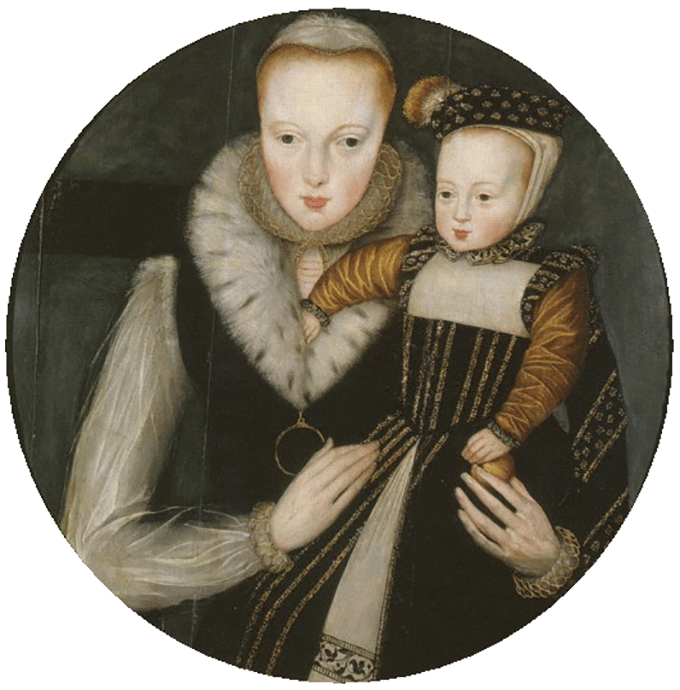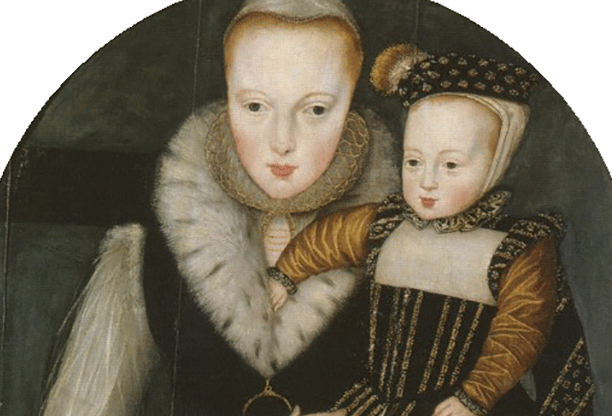Together with Tudor Times we profile a different figure every month. Here, Melita Thomas tackles Lady Katherine Grey, a woman imprisoned by her royal blood.

Lady Katherine Grey’s story is one of the saddest among many tragic tales of Tudor women. Katherine was the grand-daughter of Henry VIII’s younger sister, Mary. While not as intellectually gifted as her older sister Jane, Katherine benefited from a fashionable Humanist education and learnt Latin and Greek as well as the usual accomplishments of French and music. The other fashion the Greys followed was in religion. Her father was one of the most committed followers of the Reformed faith, and his daughters were brought up in it.
In 1547, King Henry died. His Will bequeathed the throne first to his legitimate son, now Edward VI, then his daughters Mary and Elizabeth. If these three died without heirs, Katherine’s older sister was to succeed, followed by Katherine herself. Only seven years old at the time, she probably didn’t understand any of this, but by passing over a more senior branch of the family, descended from his elder sister, Henry had raised the value of the Grey sisters, and at the same time, made them dangerous to his daughters.
Edward VI’s reign was short, and, when it became apparent that he would not beget an heir, his councillors scurried to improve their status by marrying the Grey sisters to their sons. Lady Jane was married to Guilford Dudley, son of the Duke of Northumberland, and Katherine, although only 12, to the son of the Earl of Pembroke. As the young king was dying, he tried to change the succession to bypass his Catholic sister Mary, and settle the crown on the firmly Protestant Jane. Alas for the Grey family, Jane was queen for less than two weeks before Mary triumphed and dispatched her to the Tower.

Queen Mary had always been close to Katherine’s mother, so neither she nor her two younger daughters were punished, although the Earl of Pembroke swiftly had Katherine’s marriage dissolved. Following further rebellion, Katherine’s father and sister were executed but Katherine, by then 14, was given a place of honour in the Queen’s Privy Chamber, where her status entitled her to a gentlewoman to carry her train. Sometime in 1558, Katherine met Edward Seymour, nephew of Henry VIII’s third wife, Jane. He and Katherine fell in love, but before she could ask for consent to marry, Queen Mary died.
The new queen, Elizabeth I, neither liked Katherine personally, nor, politically, did she want to show honour to a possible heir. Katherine was demoted in the palace hierarchy. Plots began to form around her – the Spanish talked of kidnapping her and the Scottish regent suggested a match with his son. Katherine wanted only to marry Seymour, now Earl of Hertford. After a year of surreptitious meetings, the two were secretly married.
Shortly after, Hertford was obliged to go abroad on government business. While he was away, Katherine discovered she was pregnant. She eventually confessed her dark secret to Elizabeth’s favourite, Robert Dudley, begging him to intercede for her. Elizabeth was incandescent with rage. While she herself was still debating marriage, the last thing she needed was a young, Protestant, mother-of-a-son waiting for her to die. Katherine was clapped in the Tower of London, and Hertford recalled to join her – although not in the same apartments. They were to be kept strictly apart. An investigation into their marriage deemed it illegal, but they were not released. Even their gaolers had sympathy for the couple and turned a blind eye to two meetings, which resulted in another pregnancy. Elizabeth’s rage knew no bounds and Hertford was fined £15,000 for “deflowering a royal virgin”.
Katherine remained languishing in the Tower. In 1563, to escape plague, she was sent to a country house in Essex while Hertford and their eldest son remained confined in London. Over the next five years Katherine was moved to a succession of houses, with different custodians. She continued to plead with Elizabeth for mercy, but it was refused. Finally, Katherine gave into despair which fatally damaged her health. She died, aged only 28. Hertford survived her by more than 50 years, but they were finally reunited when their grandson had her remains moved to lie beside his in Salisbury Cathedral.
For more on Lady Katherine Grey visit the Tudor Times.
Related articlesTudor of the month: Penelope ‘Lady Rich’ Devereaux |
Click here to subscribe! |
Download BRITAIN Magazine to your mobile today

 No mobile device? Purchase directly on Zinio for your desktop!
No mobile device? Purchase directly on Zinio for your desktop!






 © 2024
© 2024